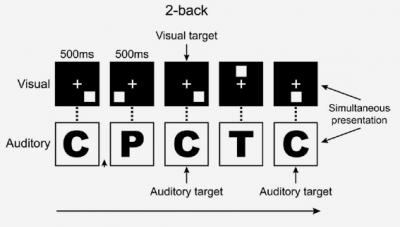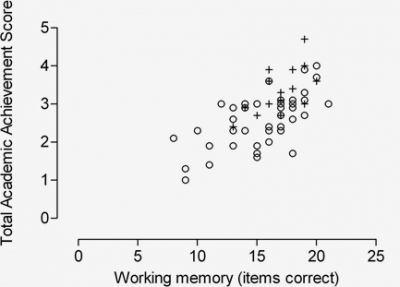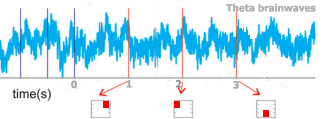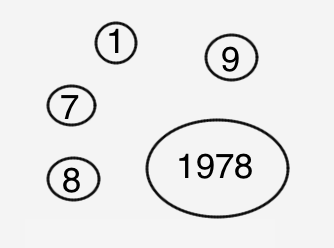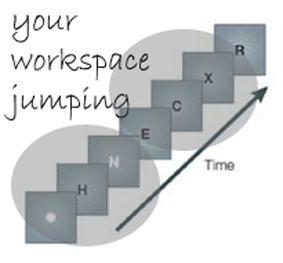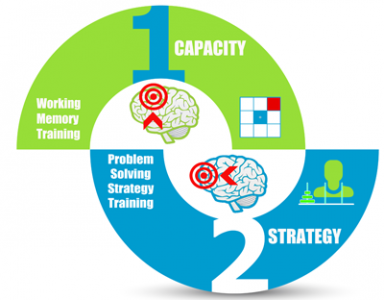HighIQPro’s innovative 2G brain training builds on well-established dual n-back training. It benefits from all that dual n-back gives you. But unlike dual n-back training it has been engineered to guarantee substantial IQ gains.
Standard N-Back Working Memory Training
The aim of all working memory (WM) training programs is to expand working memory capacity. The most widely studied brain training exercise targeting WM capacity is the dual n-back task. The N-back task involves viewing a continuous stream of items (e.g., letters) and deciding whether each item matches the stimulus presented n stimuli back. In dual n-back training, a verbal and a visuo-spatial stream of items is presented simultaneously and item matches have to be detected for both types of information.
This dual task requires updating items in both the visual short term storeand the verbal short term stores of working memory. The most well-known dual n-back task has been developed by Dr. Susanne Jaeggi and her colleagues back in 2008. We call this the ‘Standard’ dual n-back.
Known benefits of dual n-back working memory training
Working memory training has been shown in replicated studies to result in the following cognitive benefits (reviews: Morrison & Chein, 2011; Salminen, Strobach & Schubert, 2012):
- Increased performance on untrained measures of short term memory.
- Fluid intelligence (IQ) (mixed results – see below)
- Multi-tasking – i.e. attentional selection between two sets of information associated with different tasks.
- Detaching attention from irrelevant items and attending to new relevant items.
- Episodic memory.
- Reading comprehension.
- Verbal learning and every day attention in older adults (60+).
- Reduced symptoms of ADHD.
- Improvements for multiple sclerosis – everyday memory, quality of life.
- Improvements for schizophrenia patients – everyday memory, quality of life.
- Improvements for frontal lobe stroke patients.
In general terms, the larger your working memory capacity or ‘mental workspace’, the greater your capacity for higher order cognition and thus academic and professional achievement. An example of this relationship is shown below.
.
For my review of n-back working memory training effects on general cognitive performance, click on the pdf icon:
![]()
.
Limitations of Standard Dual N-Back Training
Traditional dual n-back training has a number of critical limitations including the following:
- Questionable IQ gains. With dual n-back training alone, the research is mixed as to whether or not it results in IQ gains. HighIQPro’s innovative interference control as well as its capacity-strategy method, hones in on the factors that result in IQ gains.
- Motivation. N-back training is hard and traditional n-back apps on the market have a high drop out rate because of this. HighIQPro has built in motivators that ensure that you complete the program and reap the benefits to your IQ and brain function that would otherwise not be tapped. These include leaderboards, game-like sound effects, block by block customization and IQ increase and top-score guarantees.
- Counter-productive strategies. The original Jaeggi dual n-back and its variants on the market do not counter a number of strategies to maintain or improve n-back levels without associated gains in actual working memory capacity – such as chunking, attention blinking and playing the odds. HighIQPro’s 2G training helps counter these counter-productive strategies.
2G N-Back Options in HighIQPro
Interference Control. 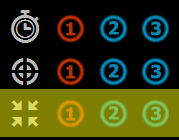 We now know that interference control is critical to high levels of fluid intelligence and working memory. Interference control is a kind of attention control – the ability to filter out distracting information or suppress irrelevant habits or responses, when faced with cognitive challenges. What is ‘interference’ in the dual n-back? You may have experienced interference in the standard dual n-back when the sequence of stimuli repeats itself before the target is presented. This creates confusion where you have to ‘repeat yourself’ to keep the series of items in memory. The level of interference in our 2G n-back can be systematically increased. You can select levels of interference in the third (arrows icon) option shown here. The default is 1 which is minimal interference. This is the standard Jaeggi n-back setting, and the setting that is used in most commercial and online n-back brain training apps. 2 and 3 settings increasing the amount of interference progressively, better activating your lateral prefrontal cortex but making the task more difficult.
We now know that interference control is critical to high levels of fluid intelligence and working memory. Interference control is a kind of attention control – the ability to filter out distracting information or suppress irrelevant habits or responses, when faced with cognitive challenges. What is ‘interference’ in the dual n-back? You may have experienced interference in the standard dual n-back when the sequence of stimuli repeats itself before the target is presented. This creates confusion where you have to ‘repeat yourself’ to keep the series of items in memory. The level of interference in our 2G n-back can be systematically increased. You can select levels of interference in the third (arrows icon) option shown here. The default is 1 which is minimal interference. This is the standard Jaeggi n-back setting, and the setting that is used in most commercial and online n-back brain training apps. 2 and 3 settings increasing the amount of interference progressively, better activating your lateral prefrontal cortex but making the task more difficult.
Studies by Burgess, Gray, and fellow grad student Tod Braver (article 1, article 2) provide brain imaging evidence of a large overlap of gF and WM span brain mechanisms when there is need for interference control on a task – but not otherwise.
Why evidence is mixed for IQ gains from dual n-back training
Some studies such as this one and this one provide evidence for IQ gains from n-back training, while others such as this one and this one do not. Why the inconsistency? An explanation for the inconsistency is that some studies may have low interference in their n-back algorithm, while others may have higher interference in their n-back algorithm – just by chance. None of the studies systematically vary interference in the n-back task. If interference is greater in the n-back, transfer to IQ gains will be greater. HighIQPro is the only app that provides users with interference control training. For the scientific basis of this setting with references click here.
2. Speed/Variability
 Electrical activity in the brain can be recorded using EEG electrodes on the scalp. Different types of brain waves (electrical oscillations) have been linked to sleep, navigation, cognition, attention, and can help diagnose a wide range of disorders including autism, schizophrenia and epilepsy.During standard dual n-back training, while our attention system keeps track of the updating letters and squares, sensory areas of the brain go into an electrical rhythm that matches the rhythm of the n-back letters and squares – for instance, every second. The n-back stimuli drive the cortex rhythmically (Lakatos et al., 2009).
Electrical activity in the brain can be recorded using EEG electrodes on the scalp. Different types of brain waves (electrical oscillations) have been linked to sleep, navigation, cognition, attention, and can help diagnose a wide range of disorders including autism, schizophrenia and epilepsy.During standard dual n-back training, while our attention system keeps track of the updating letters and squares, sensory areas of the brain go into an electrical rhythm that matches the rhythm of the n-back letters and squares – for instance, every second. The n-back stimuli drive the cortex rhythmically (Lakatos et al., 2009).
The cortical brain rhythm helps process the stimuli, anticipating when the next sounds and squares will appear, and ‘binding’ the audio and visual information together in working memory. How does this relate to real world cognition? Speech is rhythmic, our gestures are rhythmic, visual saccades (the moment to moment eye movements that we scan scenes or text with) are rhythmic. Our attention system works in these rhythms, resulting in periodic increases in excitability in anticipation of attended stimuli – making information processing more selective and efficient. The speed and variability of the stimuli in the HighIQPro n-back can be systematically increased. The default is 1 which is a regular 3 second stimulus rhythm. This is the standard Jaeggi n-back setting, and the setting that is used in most commercial and online n-back brain training apps. 2 and 3 settings increase the speed and break the rhythm of the n-back stimuli, requiring more focused attention and demands on working memory. For the scientific basis of this setting with references click here.
3. Accuracy
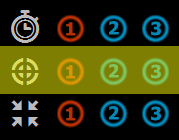 In the original Jaeggi dual n-back algorithm, staying at the same n-back level without dropping down a level requires that you are 75% accurate. Going up an n-back level requires you are 85% accurate. Because there is considerable room for error (such as missing targets) in these accuracy levels, it is possible to use game-specific strategies to improve your n-back score. These strategies do not actually help you expand your brain’s working memory capacity, although they result in increasing n-back levels and the appearance of better working memory performance. The accuracy level in our 2G n-back can be systematically increased. The default is 1 which is the standard Jaeggi accuracy settings. 2 and 3 settings increase the accuracy requirement progressively, with level 3 requiring 100% accuracy to go up an n-back level. Higher accuracy levels prevent game-specific strategies that artificially increase your n-back levels. Higher accuracy level settings help prevent the use of domain-specific strategies such as the following:
In the original Jaeggi dual n-back algorithm, staying at the same n-back level without dropping down a level requires that you are 75% accurate. Going up an n-back level requires you are 85% accurate. Because there is considerable room for error (such as missing targets) in these accuracy levels, it is possible to use game-specific strategies to improve your n-back score. These strategies do not actually help you expand your brain’s working memory capacity, although they result in increasing n-back levels and the appearance of better working memory performance. The accuracy level in our 2G n-back can be systematically increased. The default is 1 which is the standard Jaeggi accuracy settings. 2 and 3 settings increase the accuracy requirement progressively, with level 3 requiring 100% accuracy to go up an n-back level. Higher accuracy levels prevent game-specific strategies that artificially increase your n-back levels. Higher accuracy level settings help prevent the use of domain-specific strategies such as the following:
- Chunking. Sometimes during the standard dual n-back game, a letter or location may be repeated one two or even three times. When this happens it is easier perform on the n-back exercise because with only one ‘place holder’ there is less information to ‘encode’ to do the task. Or at other times, there may be a meaningful string of letters that forms a word or acronym, or the sequence of locations forms a known shape. When items can be grouped together like this, easing the burden on our memory system, this is called ‘chunking’. Chunking can also benefit from practice.
.
- Attention jumping. As you get more experienced with the standard dual n-back game it is possible to strategically direct your attention in ‘jumps’ to useful strings of letters or square locations in order to maintain or go up an n-back level. Using this strategy, you are not actually updating the items in your working memory continuously, but are ‘counting through’ a particular string of items and then refreshing it from the start again for the next string.
.
- Playing the odds. Another strategy that can be used in the standard dual n-back is ‘intelligent guessing’ when you are less precise with your location memory, for instance, but can make good guesses that the stimulus was to the left, or to the right for instance. This gives you better ‘odds’ at reach the required level of accuracy to maintain or go up an n-back level.
Using any of these strategies is counter-productive for working memory training. And here’s why. These strategies are actually ways of getting around (i.e. compensating for) limitations of working memory capacity to increase your n-back performance. But getting practice with these strategies does not actually help increase working memory capacity itself. For the scientific basis of this setting with references click here.
2G Capacity-Strategy Training in HighIQPro
HighIQPro‘s second generation n-back training combines optional problem solving training with working memory n-back training, to harness a synergy between working memory and learning problem solving strategies.
Your working memory capacity is like a computers RAM power. Having more RAM allows you to process more information faster, but it doesn’t help you know what rules and strategies to apply to the information in order to get the right results! It doesn’t help you overcome biases in how you reason, for instance. And it doesn’t help you solve problems unless you know the right strategies to apply to the problem. To learn how to do a mathematical calculation, you need to learn mathematical rules; to learn how to drive a car, you need to learn how to operate the car; to learn a second language, you need to apply grammatical rules. For overall cognitive performance, you need both cognitive capacity (a measure of the efficiency of your brain), as well as the right ‘mindware‘ – knowledge, know-how, rules, procedures and mental strategies. A larger working memory capacity functions to allow for easier learning and application of mental mindware.
Working memory circuitry is located in the lateral prefrontal cortex. Activation in this area allows for the flexible application of a wider range of novel strategies and rules, overcoming automatic responses. These new rules – with practice – are then more effectively encoded in more anterior (to the front of the head) prefrontal areas. This is shown in the ‘Capacity-Strategy’ infographic below. For the scientific basis of this setting with references click here.


